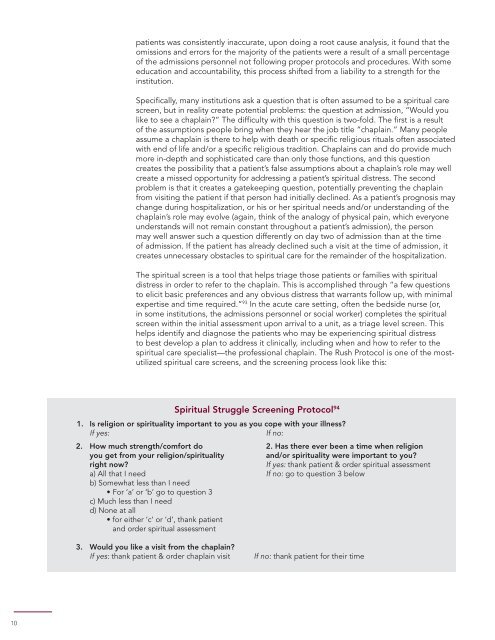S piritual Care and Nursing A Nurse’s Contribution and Practice
UsmH30a0tgV
UsmH30a0tgV
Create successful ePaper yourself
Turn your PDF publications into a flip-book with our unique Google optimized e-Paper software.
patients was consistently inaccurate, upon doing a root cause analysis, it found that the<br />
omissions <strong>and</strong> errors for the majority of the patients were a result of a small percentage<br />
of the admissions personnel not following proper protocols <strong>and</strong> procedures. With some<br />
education <strong>and</strong> accountability, this process shifted from a liability to a strength for the<br />
institution.<br />
Specifically, many institutions ask a question that is often assumed to be a s<strong>piritual</strong> care<br />
screen, but in reality create potential problems: the question at admission, “Would you<br />
like to see a chaplain?” The difficulty with this question is two-fold. The first is a result<br />
of the assumptions people bring when they hear the job title “chaplain.” Many people<br />
assume a chaplain is there to help with death or specific religious rituals often associated<br />
with end of life <strong>and</strong>/or a specific religious tradition. Chaplains can <strong>and</strong> do provide much<br />
more in-depth <strong>and</strong> sophisticated care than only those functions, <strong>and</strong> this question<br />
creates the possibility that a patient’s false assumptions about a chaplain’s role may well<br />
create a missed opportunity for addressing a patient’s s<strong>piritual</strong> distress. The second<br />
problem is that it creates a gatekeeping question, potentially preventing the chaplain<br />
from visiting the patient if that person had initially declined. As a patient’s prognosis may<br />
change during hospitalization, or his or her s<strong>piritual</strong> needs <strong>and</strong>/or underst<strong>and</strong>ing of the<br />
chaplain’s role may evolve (again, think of the analogy of physical pain, which everyone<br />
underst<strong>and</strong>s will not remain constant throughout a patient’s admission), the person<br />
may well answer such a question differently on day two of admission than at the time<br />
of admission. If the patient has already declined such a visit at the time of admission, it<br />
creates unnecessary obstacles to s<strong>piritual</strong> care for the remainder of the hospitalization.<br />
The s<strong>piritual</strong> screen is a tool that helps triage those patients or families with s<strong>piritual</strong><br />
distress in order to refer to the chaplain. This is accomplished through “a few questions<br />
to elicit basic preferences <strong>and</strong> any obvious distress that warrants follow up, with minimal<br />
expertise <strong>and</strong> time required.” 93 In the acute care setting, often the bedside nurse (or,<br />
in some institutions, the admissions personnel or social worker) completes the s<strong>piritual</strong><br />
screen within the initial assessment upon arrival to a unit, as a triage level screen. This<br />
helps identify <strong>and</strong> diagnose the patients who may be experiencing s<strong>piritual</strong> distress<br />
to best develop a plan to address it clinically, including when <strong>and</strong> how to refer to the<br />
s<strong>piritual</strong> care specialist—the professional chaplain. The Rush Protocol is one of the mostutilized<br />
s<strong>piritual</strong> care screens, <strong>and</strong> the screening process look like this:<br />
S<strong>piritual</strong> Struggle Screening Protocol 94<br />
1. Is religion or s<strong>piritual</strong>ity important to you as you cope with your illness?<br />
If yes:<br />
If no:<br />
2. How much strength/comfort do 2. Has there ever been a time when religion<br />
you get from your religion/s<strong>piritual</strong>ity<br />
<strong>and</strong>/or s<strong>piritual</strong>ity were important to you?<br />
right now?<br />
If yes: thank patient & order s<strong>piritual</strong> assessment<br />
a) All that I need If no: go to question 3 below<br />
b) Somewhat less than I need<br />
• For ‘a’ or ‘b’ go to question 3<br />
c) Much less than I need<br />
d) None at all<br />
• for either ‘c’ or ‘d’, thank patient<br />
<strong>and</strong> order s<strong>piritual</strong> assessment<br />
3. Would you like a visit from the chaplain?<br />
If yes: thank patient & order chaplain visit<br />
If no: thank patient for their time<br />
10


